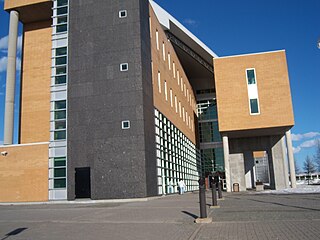Related Research Articles

Rouyn-Noranda is a city on Osisko Lake in the Abitibi-Témiscamingue region of Quebec, Canada.

Abitibi—Témiscamingue is a federal electoral district in Quebec, Canada, that has been represented in the House of Commons of Canada since 2004. The area was also represented by the electoral district of Témiscamingue from 1968 until 2004.

Abitibi-Témiscamingue is an administrative region located in western Québec, Canada, along the border with Ontario. It became part of the province in 1898. It has a land area of 57,736.50 square kilometres (22,292.19 sq mi) and its population was 147,082 people as of the 2021 census. The region is divided into five regional county municipalities and 79 municipalities. Its economy continues to be dominated by resource extraction industries. These include logging and mining all along the rich geologic Cadillac Fault between Val-d'Or and Rouyn-Noranda, as well as agriculture.

Amos is a town in northwestern Quebec, Canada, on the Harricana River. It is the seat of Abitibi Regional County Municipality.

The Université du Québec en Abitibi-Témiscamingue (UQAT) is a public university within the Université du Québec network, with campuses in Val-d'Or and Rouyn-Noranda. It takes its name from the region it primarily serves.
Villeneuve was a federal electoral district in Quebec, Canada, that was represented in the House of Commons of Canada from 1949 to 1979.

CFVS-DT, virtual channel 25.1, branded on-air as Noovo Abitibi-Témiscamingue, is a Noovo-affiliated television station licensed to Val-d'Or, Quebec, Canada and serving the Abitibi-Témiscamingue region. The station is owned by RNC Media, as part of a twinstick with TVA affiliate CFEM-DT, licensed to the neighbouring city of Rouyn-Noranda. The two stations share studios on Avenue Murdoch and Avenue de la Saint Anne in Rouyn-Noranda; CFVS-DT's transmitter is located near Route Québec Lithium in La Corne. The station operates a rebroadcaster in Rouyn-Noranda (CFVS-DT-1) on UHF channel 20. Both transmitters flash-cut to digital on September 1, 2011.

CFEM-DT, virtual and VHF digital channel 13, branded on-air as TVA Abitibi-Témiscamingue, is a TVA-affiliated television station licensed to Rouyn-Noranda, Quebec, Canada and serving the Abitibi-Témiscamingue region. The station is owned by RNC Media, as part of a twinstick with Noovo affiliate CFVS-DT, licensed to the neighbouring city of Val-d'Or. The two stations share studios on Avenue Murdoch and Avenue de la Saint Anne in Rouyn-Noranda; CFEM-DT's transmitter is located near Chemin Powell. The station operates a rebroadcaster in Val-d'Or (CFEM-DT-1) on VHF channel 10. Both transmitters flash-cut to digital on September 1, 2011.

CKRN-DT was a privately owned Ici Radio-Canada Télé-affiliated television station licensed to Rouyn-Noranda, Quebec, Canada, which essentially functioned as a semi-satellite of Montreal Radio-Canada flagship station CBFT-DT due to not having alternative non-network sources of programming available. It broadcast a digital signal on VHF channel 9 from a transmitter near Chemin Powell in Rouyn-Noranda.

Route 117, the Trans Canada Highway Northern Route, is a provincial highway within the Canadian province of Quebec, running between Montreal and the Quebec/Ontario border where it continues as Highway 66 east of McGarry, Ontario. It is an important road since it is the only direct route between southern Quebec and the Abitibi-Témiscamingue region.

Route 395 is a two-lane north/south highway located in the Abitibi-Témiscamingue region in Quebec, Canada. It starts at the junction of Route 117 in Cadillac and ends at the junction of Route 397 in La Morandière-Rochebaucourt. It is briefly concurrent with Route 111 in Amos.
Cégep de l'Abitibi-Témiscamingue is a public college-level institute of education (CEGEP) with its main campus located in Rouyn-Noranda, Quebec, Canada. The CEGEP has two additional campuses, in Amos and Val-d'Or. It was founded in 1967, and 2,500 students are currently enrolled. Programs are offered in mining and forestry, as well as social, technical, industrial, and communications professions.
Rouyn-Noranda–Témiscamingue is a provincial electoral district in the Abitibi-Témiscamingue region of Quebec, Canada, which elects members to the National Assembly of Quebec. It notably includes large portions of the city of Rouyn-Noranda as well as the cities or municipalities of Ville-Marie, Témiscaming, Lorrainville, Saint-Bruno-de-Guigues, Notre-Dame-du-Nord and Laverlochère-Angliers. No incumbent since Rémy Trudel has won re-election in the riding.
Abitibi-Est is a provincial electoral district in the Abitibi-Témiscamingue region of Quebec, Canada, that elects members to the National Assembly of Quebec. The district notably includes eastern portions of the city of Rouyn-Noranda as well as Val-d'Or, Malartic and Senneterre.
Timiskaming is a word from the Algonquin Temikami or Temikaming, from tim 'deep' and kami 'open waters'. Alternate spellings include Temiskaming, Témiscaming and Témiscamingue. The word Temagami comes from the same root.
Almost all media in the Abitibi-Témiscamingue region of Quebec serves all cities in the region, with very little differentiation between the three primary cities of Rouyn-Noranda, Val-d'Or, and Amos.
Rouyn-Noranda was a former provincial electoral district in the Abitibi-Témiscamingue region of Quebec, Canada, which elected members to the National Assembly of Quebec. It was located in and around the city of Rouyn-Noranda.
Luc Blanchette is a Canadian politician in Quebec, who was elected to the National Assembly of Quebec in the 2014 election. He represented the electoral district of Rouyn-Noranda–Témiscamingue as a member of the Quebec Liberal Party. He was initially appointed Minister for Mines and Minister responsible for the Abitibi-Témiscamingue region and the Nord-du-Québec region, and then on August 20, 2016, he left the Mines portfolio and became Minister of Forests, Wildlife and Parks. He was defeated in the 2018 election.
The Laberge River is a tributary of Lake Hebert, flowing in Canada, in:
The Abitibi-Témiscamingue International Film Festival is an annual film festival, which takes place in Rouyn-Noranda, Quebec, Canada. The festival presents a program of Canadian and international films in late October and early November each year.
References
- ↑ "Discover the Abitibi-Témiscamingue Region, in Quebec - Canada - BARNES Luxury Real Estate". BARNES Québec. Retrieved 2024-01-18.
- ↑ Canada, Come Explore. "Abitibi Temiscamingue Region in Quebec, Canada". Come Explore Canada. Retrieved 2024-01-18.